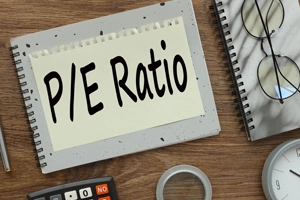
While investing in mutual funds, you will come across many ratios, each with its unique significance. One such metric is the Price-to-Earnings (PE) ratio. Although primarily associated with stocks, the PE ratio is also relevant for mutual fund investments. This article explores the importance of a PE ratio in mutual fund schemes.
What is PE ratio in mutual funds?
Before delving into its importance in mutual funds, it is essential to understand the concept of the PE ratio.
The PE ratio is a key financial metric that helps understand the valuation of a stock – whether it is cheap or expensive. It essentially reflects how much an investor is willing to pay for every rupee of earnings generated by the company.
The PE ratio formula
The PE ratio essentially helps compare the valuations of different companies. It is calculated by dividing the market price of a share by the company’s Earnings Per Share (EPS).
P/E Ratio = Market Value Per Share/Earnings Per Share
Example:
If a stock’s price is Rs 100 and its EPS is Rs 10, the PE ratio will be 10. This means investors are willing to pay Rs 10 for every Re 1 the company earns in profits.
A high PE ratio could either mean that the company’s stock is overvalued or that investors expect high growth rates in the future. Conversely, a low PE ratio indicates that the stocks could be undervalued, implying potential opportunities for investors.
How to calculate PE ratio for mutual funds?
Mutual funds invest in a diversified portfolio of stocks. Hence, the PE ratio for a mutual fund is calculated as the weighted average of the PE ratios of all the stocks in the fund’s portfolio.
PE ratio (Mutual fund) = Σ (PE ratio of each stock X Weightage of each stock in portfolio)
Stock | PE Ratio | Weight (%) | PE Ratio X Weight |
A | 24 | 38.71% | 8.4 |
B | 28 | 45.16% | 7 |
C | 10 | 16.13% | 4 |
Therefore, the PE ratio = 8.4+7+4= 19.4.
What is the importance of the PE ratio in mutual fund schemes?
The PE ratio of a mutual fund gives an idea about its investment style. A high PE ratio indicates that the fund follows a growth investing strategy. It typically invests in companies that showcase high growth potential, where share prices are expected to increase rapidly.
On the other hand, a low PE ratio signals that the fund follows a value investing approach. It primarily invests in stocks that are currently traded below their market value but have the potential to offer long-term value.
The PE ratio also helps evaluate the fund’s risk-return dynamics and suitability for different mutual fund investment horizons. Growth funds may exhibit higher volatility than value funds but may offer higher returns in the long run. Value funds are better suited for investors seeking some stability as they are relatively less volatile.
By understanding the concept of PE ratios in mutual funds, you can create a diversified portfolio that balances growth and value styles. This, in turn, can help you minimise risks and stabilise returns across various market conditions.
Things to keep in mind while assessing the PE ratio
Here are some key factors to remember before analysing the PE ratio:
- Avoid standalone analyses: Although the PE ratio is a valuable metric, you should not analyse it in isolation. For better context, you must compare the fund’s PE ratio against category or industry averages.
- Consider broader assessment metrics: The PE ratio does not consider critical factors, such as future growth potential, risk profile, or the degree of diversification within the fund. Hence, before making a decision, you must also assess other parameters, including historical performance, risk-adjusted returns, sector exposure, and the fund’s overall investment strategy.
- Avoid simplistic judgements: A high PE ratio does not indicate that a fund is unfavourable and vice versa. Understanding the underlying reasons behind the ratio is essential for making prudent decisions.
Conclusion
The PE ratio is an important financial metric that provides insights into the investment style and valuation of a mutual fund. However, to make an informed decision, it is important to understand its significance alongside other relevant factors.
An investor education initiative by Edelweiss Mutual Fund
All Mutual Fund Investors have to go through a one-time KYC process. Investors should deal only with Registered Mutual Fund (RMF). For more info on KYC, RMF and procedure to lodge/redress any complaints, visit - https://www.edelweissmf.com/kyc-norms
MUTUAL FUND INVESTMENTS ARE SUBJECT TO MARKET RISKS. READ ALL SCHEME-RELATED DOCUMENTS CAREFULLY
Trending Articles
MUTUAL FUND INVESTMENTS ARE SUBJECT TO MARKET RISKS, READ ALL SCHEME RELATED DOCUMENTS CAREFULLY.















